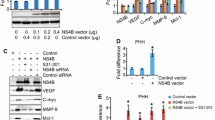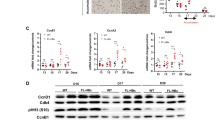Abstract
We used human hepatoma HepAD38 cells, in which HBV production is under the control of a tetracycline-regulated promotor, to investigate changes induced in the host cell by HBV replication that could contribute to malignant transformation. Parameters of oxidative stress (malondialdehyde, glutathione) and cell proliferation were determined at different times after induction (0–96 h). In HBV-producing cells, the redox status peaked at 72 h. cDNA micro array analysis at 72 h post induction revealed 3 groups of genes that were up-regulated by HBV: (i) heat shock proteins, (ii) oxidative and metabolic stress and (iii) growth and apoptosis related genes. Continuous HBV production did not accelerate karyotypic changes in cells cultured for 4 months (18 passages). In conclusion: HBV replication modulates host gene expression and induces oxidative stress. In this HepAD38 model early events (0–4 days) in the host cell after induction of HBV replication can be studied under strictly defined conditions.
Similar content being viewed by others
Abbreviations
- FCS:
-
foetal calf serum
- GSH:
-
glutathione
- GSSG:
-
oxidized glutathione
- HCC:
-
hepatocellular carcinoma
- MDA:
-
malondialdehyde
- MTT:
-
3-[4,5-dimethylthiazol-2-yl]-2,5-diphenyl tetrazolium bromide
- ROS:
-
reactive oxygen species, tet, tetracycline
References
Lok AS, Heathcote EJ, Hoofnagle JH: Management of hepatitis B: 2000-summary of a workshop. Gastroenterology 120: 1828–1853, 2001
Parkin DM, Bray F, Ferlay J, Pisani P: Estimating the world cancer burden: Globocan 2000. Int J Cancer 94: 153–156, 2001
Rabe C, Cheng B, Caselmann WH: Molecular mechanisms of hepatitis B virus-associated liver cancer. Dig Dis 19: 279–287, 2001
Kim JH, Rho HM: Activation of the human transforming growth factor alpha (TGF-alpha) gene by the hepatitis B viral X protein (HBx) through AP-2 sites. Mol Cell Biochem 231: 155–161, 2002
Dandri M, Burda MR, Burkle A, Zuckerman DM, Will H, Rogler CE, Greten H, Petersen J: Increase in de novo HBV DNA integrations in response to oxidative DNA damage or inhibition of poly(ADP-ribosyl)ation. Hepatology 35: 217–223, 2002
Nakamura H, Nakamura K, Yodoi J: Redox regulation of cellular activation. Annu Rev Immunol 15: 351–369, 1997
Jones DP: Redox potential of GSH/GSSG couple: Assay and biological significance. Methods Enzymol 348: 93–112, 2002
Nkabyo YS, Ziegler TR, Gu LH, Watson WH, Jones DP: Glutathione and thioredoxin redox during differentiation in human colon epithelial (Caco-2) cells. Am J Physiol Gastrointest Liver Physiol 283: G1352–1359, 2002
Schafer FQ, Buettner GR: Redox environment of the cell as viewed through the redox state of the glutathione disulfide/glutathione couple. Free Radic Biol Med 30: 1191–1212, 2001
Nagoev BS, Abidov MT, Ivanova MR: LPO and free-radical oxidation parameters in patients with acute viral hepatitis. Bull Exp Biol Med 134: 557–558, 2002
Filomeni G, Rotilio G, Ciriolo MR: Glutathione disulfide induces apoptosis in U937 cells by a redox-mediated p38 MAP kinase pathway. Faseb J 17: 64–66, 2003
Shimoda R, Nagashima M, Sakamoto M, Yamaguchi N, Hirohashi S, Yokota J, Kasai H: Increased formation of oxidative DNA damage, 8-hydroxydeoxyguanosine, in human livers with chronic hepatitis. Cancer Res 54: 3171–3172, 1994
Sells MA, Chen ML, Acs G: Production of hepatitis B virus particles in Hep G2 cells transfected with cloned hepatitis B virus DNA. Proc Natl Acad Sci USA 84: 1005–1009, 1987
Ladner SK, Otto MJ, Barker CS, Zaifert K, Wang GH, Guo JT, Seeger C, King RW: Inducible expression of human hepatitis B virus (HBV) in stably transfected hepatoblastoma cells: A novel system for screening potential inhibitors of HBV replication. Antimicrob Agents Chemother 4: 1715–1720, 1997
Ying C, van Pelt JF, Van Lommel A, Van Ranst M, Leyssen P, De Clercq E, Neyts J., et al: Sulphated and sulphonated polymers inhibit the initial interaction of hepatitis B virus with hepatocytes. Antivir Chem Chemother 13: 157–164, 2002
Akerboom TPM, Sies H: Assay of glutathione, glutathione disulfide, and glutathione mixed disulfides in biological samples. Methods Enzymol 77: 373–382, 1981
Jentzsch AM, Bachmann H, Furst P, Biesalski HK: Improved analysis of malondialdehyde in human body fluids. Free Radic Biol Med 20: 251–256, 1996
Gong ZJ, De Meyer S, van Pelt J, et al: Transfection of a rat hepatoma cell line with a construct expressing human liver annexin V confers susceptibility to hepatitis B virus infection. Hepatology 29: 576–584, 1999
Livezey KW, Negorev D, Simon D: Hepatitis B virus-transfected Hep G2 cells demonstrate genetic alterations and de novo viral integration in cells replicating HBV. Mutat Res 452: 163–178, 2000
Nakanishi F, Ohkawa K, Ishida H, Hosui A, Sato A, Hiramatsu N, Ueda K, Takehara T, Kasahara A, Sasaki Y, Hori M, Hayashi N: Alteration in gene expression profile by full-length hepatitis B virus genome. Intervirology 48: 77–83, 2005
Bartsch H, Nair J: Oxidative stress and lipid peroxidation-derived DNA-lesions in inflammation driven carcinogenesis. Cancer Detect Prev 28: 385–391, 2004
Block TM, Mehta AS, Fimmel CJ, Jordan R: Molecular viral oncology of hepatocellular carcinoma. Oncogene 22: 5093–5107, 2003
Dalton T, Palmiter RD, Andrews GK: Transcriptional induction of the mouse metallothionein-I gene in hydrogen peroxide-treated Hepa cells involves a composite major late transcription factor/antioxidant response element and metal response promoter elements. Nucleic Acids Res 22: 5016–5023, 1994
Zhu XD, Li CL, Lang ZW, Gao GF, Tien P: Significant correlation between expression level of HSP gp96 and progression of hepatitis B virus induced diseases. World J Gastroenterol 10: 1141–1145, 2004
Shin HJ, Kim SS, Cho YH, Lee SG, Rho HM: Host cell proteins binding to the encapsidation signal epsilon in hepatitis B virus RNA. Arch Virol 147: 471–491, 2002
Author information
Authors and Affiliations
Corresponding author
Rights and permissions
About this article
Cite this article
Severi, T., Ying, C., Vermeesch, J.R. et al. Hepatitis B virus replication causes oxidative stress in HepAD38 liver cells. Mol Cell Biochem 290, 79–85 (2006). https://doi.org/10.1007/s11010-006-9167-x
Received:
Accepted:
Published:
Issue Date:
DOI: https://doi.org/10.1007/s11010-006-9167-x




